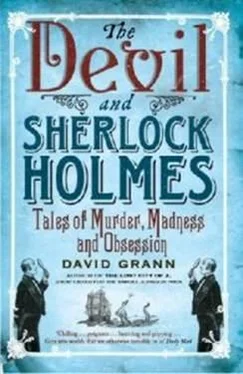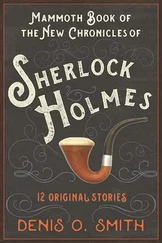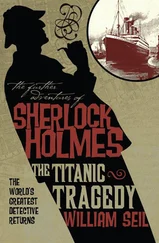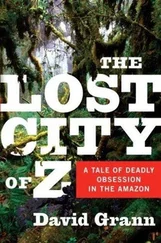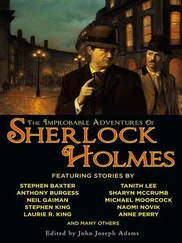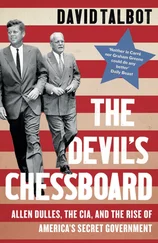What is most striking about the story, though, is that the two great logicians have descended into illogic-they are paranoid, and consumed only with each other. At one point, Moriarty tells Holmes, “This is not danger… It is inevitable destruction.” Finally, the two converge on a cliff overlooking Reichenbach Falls, in Switzerland. As Watson later deduces from evidence at the scene, Holmes and Moriarty struggled by the edge of the precipice before plunging to their deaths. After finishing the story, Conan Doyle wrote in his diary, with apparent delight, “Killed Holmes.”
As the American spoke of these details, he seemed stunned that Conan Doyle had gone through with such an extraordinary act. Still, he pointed out, Conan Doyle could not escape from his creation. In England, men reportedly wore black armbands in mourning. In America, clubs devoted to the cause “Let’s Keep Holmes Alive” were formed. Though Conan Doyle insisted that Holmes’s death was “justifiable homicide,” readers denounced him as a brute and demanded that he resuscitate their hero; after all, no one had actually seen him go over the cliff. As Green wrote in a 1983 essay, “If ever a murderer was to be haunted by the man he had killed and to be forced to atone for his act, it was the creator, turned destroyer, of Sherlock Holmes.” In 1901, under increasing pressure, Conan Doyle released “The Hound of the Baskervilles,” about an ancient family curse, but the events in the story antedated Holmes’s death. Then, two years later, Conan Doyle succumbed completely, and began writing new Holmes stories, explaining, less than convincingly, in “The Adventure of the Empty House,” that Holmes had never plunged to his death but merely arranged it to look that way so he could escape from Moriarty’s gang.
The American told me that even after Conan Doyle died Holmes continued to loom over his descendants. “Dame Jean thought that Sherlock Holmes was the family curse,” he said. Like her father, he said, she had tried to draw attention to his other works but was constantly forced to tend to the detective’s thousands of fans-many of whom sent letters addressed to Holmes, requesting his help in solving real crimes. In a 1935 essay entitled “Sherlock Holmes the God,” G. K. Chesterton observed of Sherlockians, “It is getting beyond a joke. The hobby is hardening into a delusion.”
Several actors who played Holmes were also haunted by him, the American said. In a 1956 autobiography, “In and Out of Character,” Basil Rathbone, who played the detective in more than a dozen films, complained that because of his portrayal of Holmes his renown for other parts, including Oscar-nominated ones, was “sinking into oblivion.” The public conflated him with his most famous character, which the studio and audience demanded he play again and again, until by the end he, too, lamented that he “could not kill Mr. Holmes.” Another actor, Jeremy Brett, had a breakdown while playing the detective and was eventually admitted to a psychiatric ward, where he was said to have cried out, “Damn you, Holmes!”
At one point, the American showed me a thick book, which he had brought to the pub. It was part of a multivolume history that he was writing on the Baker Street Irregulars and Sherlockian scholarship. He had started the project in 1988. “I thought if I searched pretty assiduously I’d find enough material to do a single hundred-and-fifty-page volume,” he said. “I’ve now done five volumes of more than fifteen hundred pages, and I’ve only gotten up to 1950.” He added, “It’s been a slippery slope into madness and obsession.”
As he spoke of his fascination with Holmes, he recalled one of the last times he had seen Green, three years earlier, at a symposium at the University of Minnesota. Green had given a lecture on “The Hound of the Baskervilles.” “It was a multimedia presentation about the origins of the novel, and it was just dazzling,” the American said. He repeated the word “dazzling” several times (“It’s the only word to describe it”), and as he sat up in his chair and his eyes brightened I realized that I was talking not to Green’s Moriarty but to his soul mate. Then, catching himself, he reminded me that he had a full-time job and a family. “The danger is if you have nothing else in your life but Sherlock Holmes,” he said.
In 1988, Richard Green made a pilgrimage to Reichenbach Falls to see where his childhood hero had nearly met his demise. Conan Doyle himself had visited the site in 1893, and Green wanted to repeat the author’s journey. Standing at the edge of the falls, Green stared at the chasm below, where, as Watson noted after he called out, “My only answer was my own voice reverberating in a rolling echo from the cliffs around me.”
By the mid-nineteen-nineties, Green knew that he would not have access to the Conan Doyle archive until Dame Jean died-presuming that she bequeathed the papers to the British Library. In the meantime, he continued researching his biography, which, he concluded, would require no less than three volumes: the first would cover Conan Doyle’s childhood; the second, the arc of his literary career; the third, his descent into a kind of madness.
Relying on public documents, Green outlined this last stage, which began after Conan Doyle started using his powers of observation to solve real-world mysteries. In 1906, Conan Doyle took up the case of George Edalji, a half-Parsi Indian living near Birmingham, who faced seven years of hard labor for allegedly mutilating his neighbors’ cattle during the night. Conan Doyle suspected that Edalji had been tagged as a criminal merely because of his ethnicity, and he assumed the role of detective. Upon meeting his client, he noticed that the young man was holding a newspaper inches from his face.
“Aren’t you astigmatic?” Conan Doyle asked.
“Yes,” Edalji admitted.
Conan Doyle called in an ophthalmologist, who confirmed that Edalji’s malady was so severe that he was unable to see properly even with glasses. Conan Doyle then trekked to the scene of the crime, traversing a maze of railroad tracks and hedges. “I, a strong and active man, in broad daylight, found it a hard matter to pass,” he later wrote. Indeed, he contended, it would have been impossible for a nearly blind person to make the journey and then slaughter an animal in the pitch black of night. A tribunal soon concurred, and the New York Times declared, “CONAN DOYLE SOLVES A NEW DREYFUS CASE.”
Conan Doyle even helped in solving the case of a serial killer, after he spotted newspaper accounts in which two women had died in the same bizarre manner: the victims were recent brides, who had “accidentally” drowned in their bathtubs. Conan Doyle informed Scotland Yard of his theory, telling the inspector, in an echo of Holmes, “No time is to be lost;” the killer, dubbed “the Bluebeard of the Bath,” was subsequently caught and convicted in a sensational trial.
Around 1914, Conan Doyle tried to apply his rational powers to the most important matter of his day-the logic of launching the First World War. He was convinced that the war was not simply about entangling alliances and a dead archduke; it was a sensible way to restore the codes of honor and moral purpose that he had celebrated in his historical novels. That year, he unleashed a spate of propaganda, declaring, “Fear not, for our sword will not be broken, nor shall it ever drop from our hands.” In the Holmes story “His Last Bow,” which is set in 1914, the detective tells Watson that after the “storm has cleared” a “cleaner, better, stronger land will lie in the sunshine.”
Though Conan Doyle was too old to fight, many of his relatives heeded his call “to arms,” including his son Kingsley. The glorious battle Conan Doyle envisioned, however, became a cataclysm. The products of scientific reason-machines and engineering and electronics-were transformed into agents of destruction. Conan Doyle visited the battlefield by the Somme, where tens of thousands of British soldiers died, and where he later reported seeing a soldier “drenched crimson from head to foot, with two great glazed eyes looking upwards through a mask of blood.” In 1918, a chastened Conan Doyle realized that the conflict was “evidently preventable.” By that time, ten million people had perished, including Kingsley, who died from battle wounds and influenza.
Читать дальше
